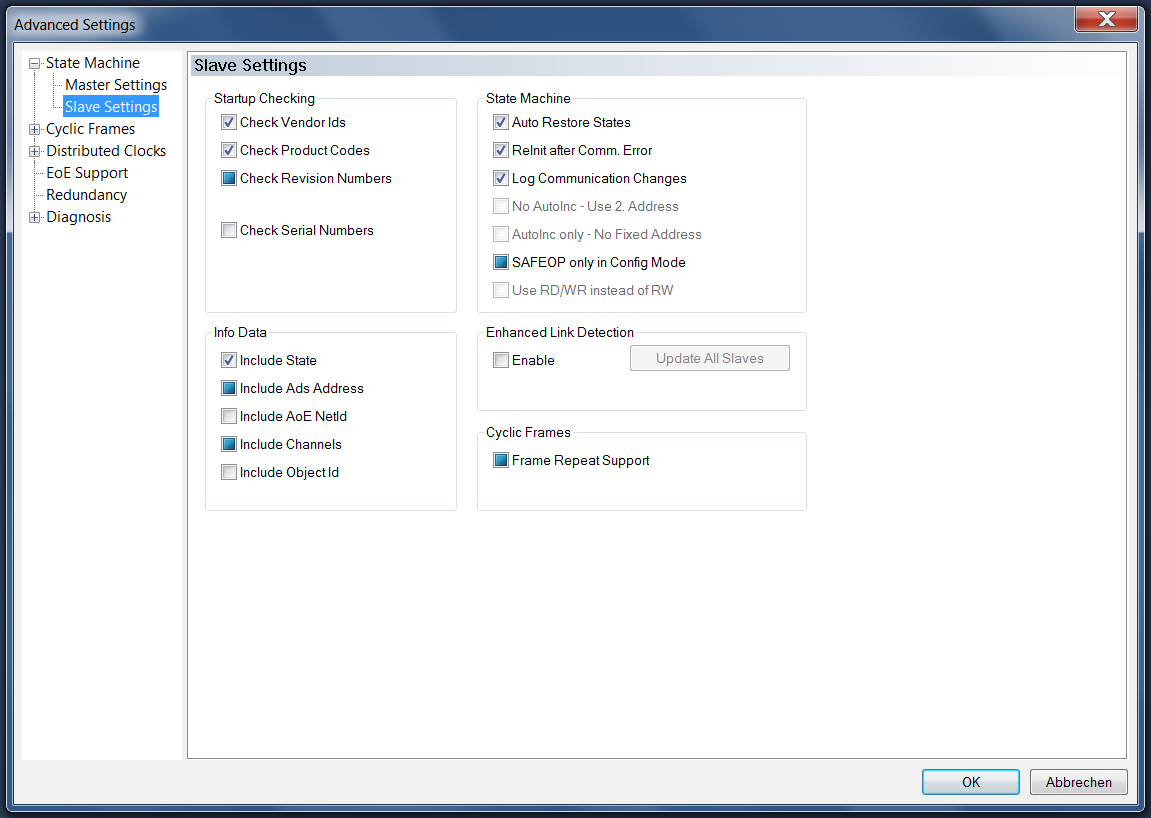State Machine Slave Settings
State Machine Slave Settings

Startup Checking
The user can determine which slave information is to be checked by the master at start-up. Settings in the configuration of the slave devices precede the settings here.
By default, the vendor IDs and product codes are checked. This approach is recommended as it allows the use of more advanced (but of the same type) devices with a higher revision in the event of a replacement.
Check Vendor Ids:
If this checkbox is checked, the master checks if the vendor ID of each slave device matches the configured one.
Check Product Codes:
If this checkbox is checked, the master checks if the product code of each slave device matches the configured one.
Checking Revision Numbers:
If this checkbox is checked, the master checks whether the revision number of each slave device matches the configured one.
Check Serial Numbers:
If this checkbox is checked, the master checks whether the serial number of each slave device matches the configured one.
Info Data
To activate this group of checkboxes, the "Enable" checkbox in the "Info Data" group of the "Master Settings" dialog must be checked.
Include State:
If this checkbox is checked, the "State" input variable is added to the "InfoData" entry of each EtherCAT slave device.
Include Ads Address:
If this checkbox is checked, the "AdsAddr" input variable is added to the "InfoData" entry of each EtherCAT slave device. This variable is added by default for all EtherCAT slave devices that support a mailbox protocol such as CoE (CANopen over EtherCAT) or SoE.
Include AoE NetId:
If this checkbox is checked, the "NetID" for "ADS over EtherCAT" is added to the "InfoData" entry. This setting is disabled by default.
State Machine
Auto Restore States:
If this checkbox is checked, the EtherCAT master device tries to automatically restore the original state of an EtherCAT slave device before the error after an error state.
Alternatively, the state of a slave device can be set and monitored from the application. In this way, the application can control the slave device in accordance with application-specific requirements.
ReInit after Comm. Error:
If this checkbox is checked and communication to a slave device has been interrupted, the master device restarts the slave device with the "INIT" state as soon as the connection is restored. Thus, after the connection has been restored, the devices also passes through the "INIT" state if the slave device has only reverted to the "SAFEOP" state. In this way, a safe start-up is ensured and the slave device reaches an unambiguous state.
No AutoInc – Use 2. Address:
If this checkbox is checked, the EtherCAT master device does not address the EtherCAT slave devices in the start-up phase on the basis of the position in the EtherCAT ring, but it reads fixed addresses from the slave devices (EtherCAT Addr.).
AutoInc only – No Fixed Address:
If this checkbox is checked, the EtherCAT master device does not address the EtherCAT slave devices in the start-up phase by reading fixed addresses from the slave devices (EtherCAT Addr.), but by means of the position in the EtherCAT ring.
SAFEOP only in Config Mode:
If this checkbox is checked, in Config mode the slave devices do not attempt to enter the Operational state when the Freerun mode is enabled, but only the Safe Operational state.
Use RD/WR instead of RW:
If the checkbox "Use RD/WR instead of RW" is checked, an RW command is split into an RD command and a WR command. This turns a single datagram for the RW command into two datagrams, one for the RD command and one for the WR command. Each datagram is terminated by a dedicated Working Counter. For this reason, a separate diagnosis option for reading and a separate diagnosis option for writing is created when the RW command is split. In this way, if an error occurs, the system can check whether the error occurs during reading or writing.
Enhanced Link Detection
Enable:
The "Enable" checkbox under the "Enhanced Link Detection" heading enables advanced connection detection in configuration mode. Especially with screw connections it can happen that port A is connected correctly but port B is not, for example. If a port is not correctly connected, it is disabled by the corresponding slave device. If a port has been disabled, the EtherCAT telegram is forwarded from the Tx of the disabled port to the Rx of the disabled port. In this way the EtherCAT telegram returns to the master device.
Cyclic Frames
Frame Repeat Support:
The TwinCAT EtherCAT master device supports multiple transfer of EtherCAT frames for increased interference immunity. The EtherCAT slave devices used and affected must support this feature. The slave device manufacturer specifies this in the ESI description. Multiple sending of frames can be switched on and off here.